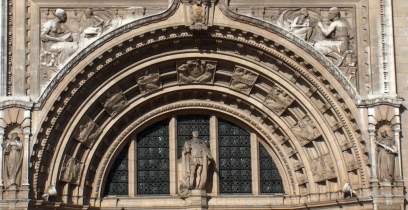
Sir Aston Webb's design for the new Victoria and Albert Museum dates from 1891, but the actual building of the structure had to wait for a budget surplus in 1898, with building commencing the following year and completion taking a further decade. This page notes exterior sculpture on the Museum, including the Portland Stone facings, but not the terra cotta extension further along Cromwell Road.
The frontages of the V&A museum onto Exhibition Road and Cromwell Road incorporate 32 statues of great British artists, architects and craftsmen, mostly made by some of the leading sculptors of the day. As well, the grand portico onto Cromwell Road has further statues and allegorical sculpture by some of the main so-called New Sculptors, including much work by Alfred Drury, and representative work by George Frampton and Edouard Lanteri.
The list below gives the names and sculptors of firstly the Exhibition Road statues (10 craft workers), and then the Cromwell Road statues (10 painters, 6 sculptors, 6 architects), with links to the sculptors, and to those depicted, where these are covered elsewhere on these pages. Many of these pictures need clicking on to enlarge to appreciate them properly.
Exhibition Rd
St Dunstan, William Torel, William Caxton, George Heriot, Huntingdon Shaw, Thomas Tompion, Chippendale, Wedgwood, Roger Payne and William Morris.
Gibbons, John Bacon, John Flaxman, Chantrey, J. H. Foley, Alfred Stevens, Hogarth, Reynolds, Gainsborough, Romney, Richard Cosway and Turner.
John Constable, G. F. Watts, Lord Leighton, J. E. Millais, William of Wykeham, John Thorpe, Inigo Jones, Chris. Wren, William Chambers, Charles Barry.
We can comment on the choice of the 19th Century men. Five fit directly with the sympathies of this website - William Morris, G. F. Watts, Leighton, and Millais, and the sculptor Alfred Stevens. Rossetti was not close enough to the establishment to get a place, but one might have thought Burne-Jones would have fitted the bill. The only Victorian architect to make it is Charles Barry, understandably given the Houses of Parliament, but again, Gilbert Scott might have been an obvious further choice. Remarking on the sculptors, we may note that most are by established names, but that Vincent Hill, Sidney Boyes, and H Rander (Myrander?) are obscure in the extreme, at least to me. The reason is that these three, along with Richard Goulden who became significant later on, were students at the College of Art at the time, whose work was supervised by Prof Lanteri there. We can only surmise that the three did not succeed as sculptors, or if they did so, did it elsewhere than in England.
Each statue stands atop a pillar, in a niche which, though elbows and cloaks may protrude, serves well to preserve the detail of the relatively soft stone. Accoutrements are relatively small - a good range of palettes, tools and scrolls in the hand, or discretely on the base. There is merit in all, but I particularly like the Leighton, Olympian as always, the Bacon, who works on a small sculpture of a girl, the characterful Alfred Stevens in a smock with some medallion on his chest, the lyrical Caxton, and the hard-faced Wykeham.
On to the main entrance. You need to stand almost in the road to see this properly, and after your visit to the V&A, cross to the other side of the road and see the full thing too. The sculptural elements include the following:
To appreciate the remaining figure sculpture on the exterior of the building, you really need binoculars. At the very top, nicely silhouetted on bright days, a statue of Fame with a starburst halo, by Edouard Lanteri, and also by him, above the pediment and below the many-pillared tower, two further allegorical figures by the same sculptor - Architecture, carrying the capital of an ionic pillar (pictured part way down this page), and Sculpture, bearing a mallet and a small sphinx.
So much for the exterior sculpture on the V&A, a pantheon to prepare you for the art within...
Up Exhibition Road to the Albert Memorial // Or up Exhibition Road and left to the Exhibition Memorial
Visits to this page from 13 Mar 2014: 14,556